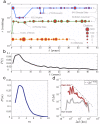Career on the move: geography, stratification, and scientific impact
- PMID: 24759743
- PMCID: PMC3998072
- DOI: 10.1038/srep04770
Career on the move: geography, stratification, and scientific impact
Abstract
Changing institutions is an integral part of an academic life. Yet little is known about the mobility patterns of scientists at an institutional level and how these career choices affect scientific outcomes. Here, we examine over 420,000 papers, to track the affiliation information of individual scientists, allowing us to reconstruct their career trajectories over decades. We find that career movements are not only temporally and spatially localized, but also characterized by a high degree of stratification in institutional ranking. When cross-group movement occurs, we find that while going from elite to lower-rank institutions on average associates with modest decrease in scientific performance, transitioning into elite institutions does not result in subsequent performance gain. These results offer empirical evidence on institutional level career choices and movements and have potential implications for science policy.
Figures






Similar articles
-
Hot streaks in artistic, cultural, and scientific careers.Nature. 2018 Jul;559(7714):396-399. doi: 10.1038/s41586-018-0315-8. Epub 2018 Jul 11. Nature. 2018. PMID: 29995850
-
Lifetime earnings patterns, the distribution of future Social Security benefits, and the impact of pension reform.Soc Secur Bull. 2000;63(4):74-98. Soc Secur Bull. 2000. PMID: 11641991
-
The future of Cochrane Neonatal.Early Hum Dev. 2020 Nov;150:105191. doi: 10.1016/j.earlhumdev.2020.105191. Epub 2020 Sep 12. Early Hum Dev. 2020. PMID: 33036834
-
Building a Professional Identity and an Academic Career Track in Translational Medicine.Front Med (Lausanne). 2019 Jul 3;6:151. doi: 10.3389/fmed.2019.00151. eCollection 2019. Front Med (Lausanne). 2019. PMID: 31334235 Free PMC article.
-
Careers in nanomedicine and drug delivery.Adv Drug Deliv Rev. 2019 Apr;144:180-189. doi: 10.1016/j.addr.2019.06.009. Epub 2019 Jun 28. Adv Drug Deliv Rev. 2019. PMID: 31260712 Free PMC article. Review.
Cited by
-
The evolution of your success lies at the centre of your co-authorship network.PLoS One. 2015 Mar 11;10(3):e0114302. doi: 10.1371/journal.pone.0114302. eCollection 2015. PLoS One. 2015. PMID: 25760732 Free PMC article.
-
Early-career setback and future career impact.Nat Commun. 2019 Oct 1;10(1):4331. doi: 10.1038/s41467-019-12189-3. Nat Commun. 2019. PMID: 31575871 Free PMC article.
-
Disambiguation of patent inventors and assignees using high-resolution geolocation data.Sci Data. 2017 May 16;4:170064. doi: 10.1038/sdata.2017.64. Sci Data. 2017. PMID: 28509897 Free PMC article.
-
Quantifying the diaspora of knowledge in the last century.Appl Netw Sci. 2016;1(1):15. doi: 10.1007/s41109-016-0017-9. Epub 2016 Nov 29. Appl Netw Sci. 2016. PMID: 30533507 Free PMC article.
-
Evolution and transformation of early modern cosmological knowledge: a network study.Sci Rep. 2020 Nov 13;10(1):19822. doi: 10.1038/s41598-020-76916-3. Sci Rep. 2020. PMID: 33188234 Free PMC article.
References
-
- Auriol L. Labour market characteristics and international mobility of doctorate holders: results for seven countries. OECD STI Working Papers 2, 37–37 (2007).
-
- Auriol L. Careers of doctorate holders: employment and mobility patterns. OECD STI Working Papers 4, 30–30 (2010).
-
- Van Noorden R. Global mobility: Science on the move. Nature 490, 326–329 (2012). - PubMed
-
- Schiermeier Q. Career choices: The mobility imperative. Nature 470, 563–564 (2011). - PubMed
-
- Jans G. et al. Study on mobility patterns and career paths of eu researches. Tech. Rep., European Commission (2010).
Publication types
LinkOut - more resources
Full Text Sources
Other Literature Sources

